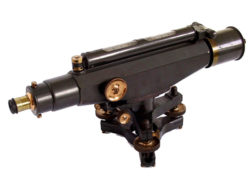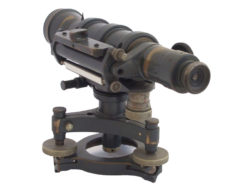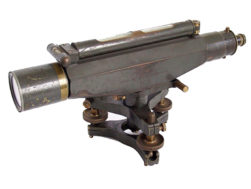Description
Troughton & Simms 14 in dumpy level with 4 in compass dial and a 4-screw levelling head. Used for measuring vertical distances between points in conjunction with a levelling staff.
Gordon Masterton, ICE Past President, wrote the following tribute to Kenneth McCrae following his death on 8 September 2007. It was published in Civils Scotland (Issue 6 07) published by ICE Scotland.
Kenneth McCrae, civil engineer, died peacefully on Saturday 8th September at the age of 92, while seated in a chair, reading a book at his home in Castle Douglas. His career encompassed work in the public service throughout Britain and the Colonies in the mid 20th century, and he was a fine example of the itinerant civil engineer working for the public good and the betterment of our quality of life.
After his early education at Glasgow High School, he was apprenticed (unpaid!) for five years with Babtie Shaw and Morton. He refined his professional skills under the mentoring of leading engineers John T Babtie, James Banks and Ritchie Campbell on water supply projects such as the Afton Dam and Reservoir, and sewerage works at Armadale, Dumbarton and Hamilton. In 1937 he moved to North Wales as Resident Engineer for the Western Valleys Sewerage Board, winning a Miller Prize from the ICE in 1939 for his paper on the scheme. He later became Assistant Engineer in the Borough of Colchester’s Water Department.
In wartime he was keen to join the Royal Navy, but his occupation was reserved, so in 1941 he successfully applied to a Crown Agents advertisement for the Department of Irrigation and Drainage in Malaya. He described travelling to Singapore in wartime (via New York, Panama Canal, and Sydney) as “quite an adventure”, but this would prove to be tame compared to his return trip.
He arrived in Malaya in November 1941, and the Japanese attack began a fortnight later. In the emergency, he achieved his ambition and joined the Royal Navy (after a very cursory medical). A fortnight later he left Singapore one day ahead of the Japanese, by applying his engineering skills to fix the steam engine of a tug that took a party to Pelambang in Sumatra, where there was felt to be a chance of refuelling. A fortunate choice: all the shipping that chose the Malacca Straits that day was sunk. Abandoning the tug, the final leg of the journey was by steam train across Sumatra, also driven by Kenneth, and a final crossing to Java.
He was then sent to Ceylon with the RNVR mainly engaged on naval salvage work until he contracted tuberculosis and was sent for recuperation to the military sanatorium in Johannesburg, finally being invalided out in 1944. He remained in South Africa with a consultancy engaged on water supply schemes and hydro projects in Natal, Livingstone and Johannesburg.
He then decided that he should return to Britain and he worked in Exeter in 1947, designing water supply and sewerage schemes, returning to South Africa with a new wife, Heather, and for the next six years gained experience in constructing and designing major projects as diverse as sewage plants, oil depots and goldfields. His final contribution to the development of southern Africa, was with the Colonial Development Corporation directing construction of the Swaziland Irrigation Scheme. Kenneth described his time in pre-apartheid Swaziland as the happiest years of his career.
Their son Robert was born in Swaziland in 1953. In 1954, his wanderlust satiated, and recognising the practical needs involved with raising a family, the family returned to Kenneth’s native Scotland as Depute County Engineer for Dumfries County Council (the County Engineer John Fletcher coincidentally had been a fellow apprentice in Babtie) and he concluded his career in an exciting and varied period of development and improvement of the county’s systems of water supply and distribution, sewerage treatment and waste disposal, including the design and construction of the cooling water supply to Chapelcross Power Station, many service reservoirs and pipelines, and an innovative composting plant at Lockerbie in which sewage sludge was mixed with household waste to produce a marketable product they named “Eradite” (after the Edinburgh Road Area Drainage scheme where the first trials were completed). He also delivered sewerage schemes for Thornhill and Locharbriggs, and the footbridge over the Nith connecting Dumfries Academy to its playing fields.
After retirement, Kenneth continued to be actively involved in the work of the Institution of Civil Engineers and gave invaluable help in recording and promoting historical engineering works in Dumfries & Galloway. He played a key role in promoting engineering history locally through visits, lectures and leaflets, in siting and resiting the Telford Memorial at Bentpath and, in serving on the committee which tastefully refurbished the Westerkirk Parish Library, originally funded by a Telford bequest. He leaves a son, Robert (now project managing the Gautrain project in Johannesburg) and a daughter Anne. A second son, Peter, also a civil engineer, was tragically killed in a vehicle accident in 1989, and is commemorated each year by the Peter McCrae Memorial Lecture organised by the ICE’s Scottish Hydraulics Study Group, an event Kenneth was pleased to attend until very recently. It was fitting that Kenneth’s final engagement was in Langholm to commemorate the 250th anniversary of Telford’s birth on 9th August. Kenneth cut the cake and proposed the toast to Thomas Telford, first President of the Institution and founder of the profession that Kenneth had followed with such dedication and integrity.





